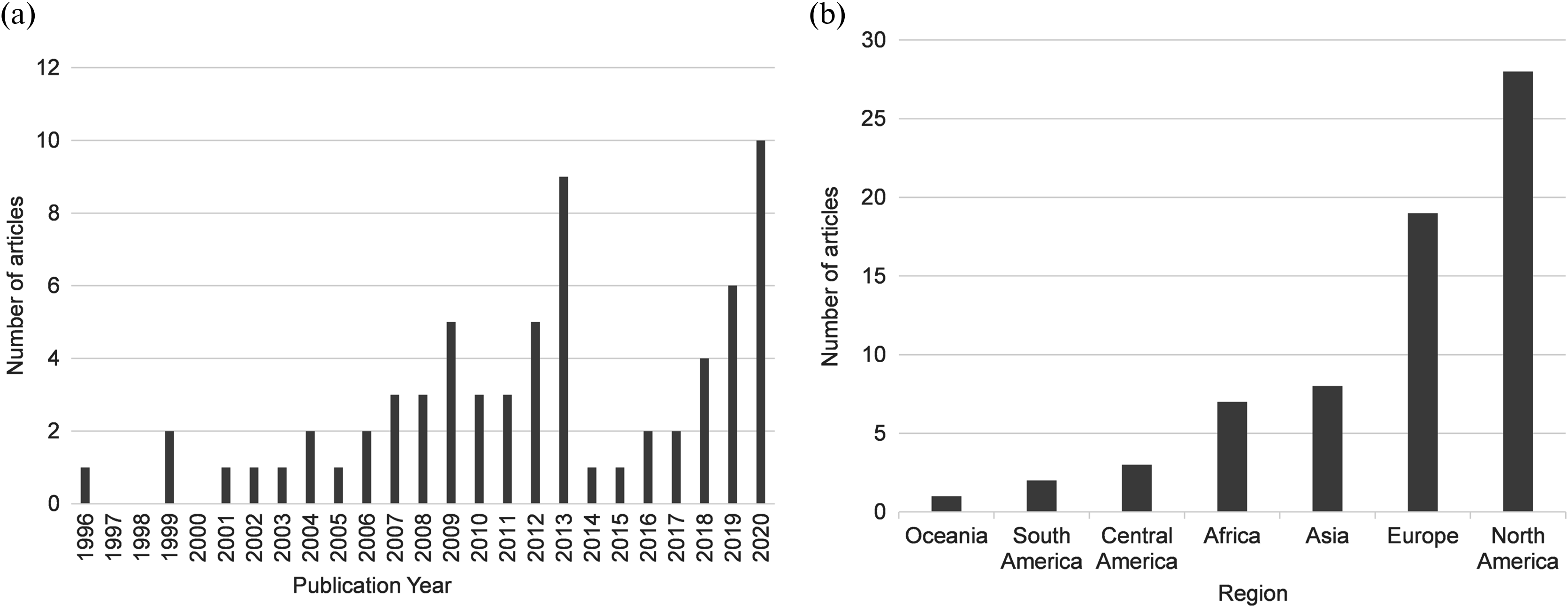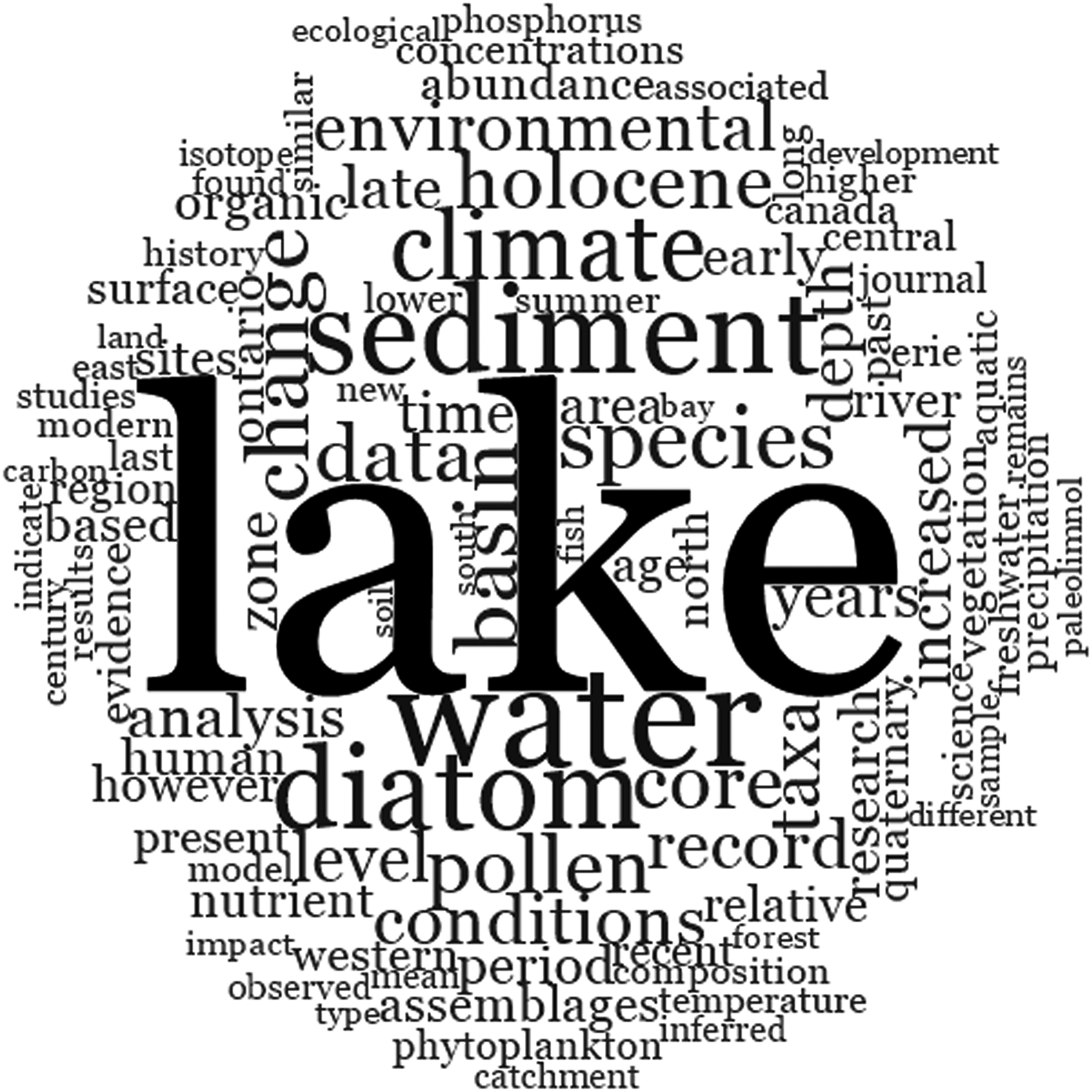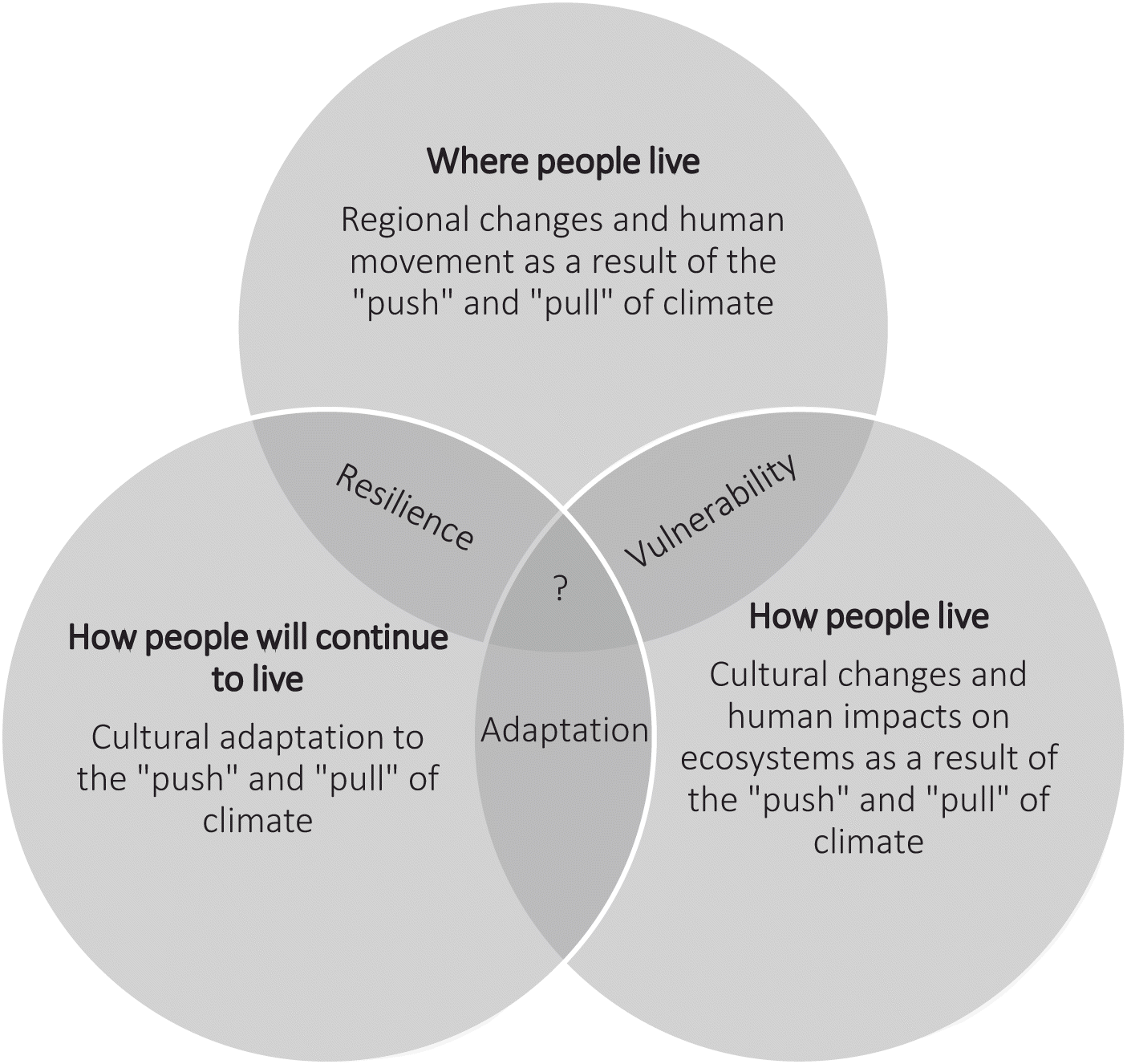Introduction
Changes in the natural environment challenge the resilience of societies, as environmental stress can promote or inhibit adaptation to change (
Diamond 2005). Food and livelihood security, in particular, can be threatened by unforeseen and gradual environmental changes that influence cultural health and continuity should adaptation to new conditions not take place within communities (
Davies 1993;
Newell et al. 2020). Adaptation can be defined as both short-term coping strategies as well as long-term transformations in relation to environmental changes (
Davies 1993). Climate change is often a driving force that affects the suitability or practicality of a region that can either “push” human groups to leave some regions or “pull” them to move to others (
Friesen et al. 2020). For example,
Carto et al. (2009) suggested large-scale changes in climate during the last glacial cycle created inhospitable conditions in Africa that led to one of the earliest migrations of humans into other regions of the world. Smaller-scale changes in climate can also have push and pull effects that influence the resilience of cultural practices and the ability to adopt new strategies (
Van Aalst et al. 2008); small fluctuations in precipitation, like those observed in Amazonia for example, allowed for the onset of agricultural practices (
Bush et al. 2000). The lasting effect from a push or pull of climate is felt globally and is especially pertinent for northern regions where polar amplification of warming can amplify the influence of climate on cultural development (
Wooller et al. 2018;
Friesen et al. 2020).
Hunter–gatherer (subsistence) and sharing economies have been a fundamental component of the culture, identity, and sustainability of human society throughout the history of the Pleistocene era (
Stutz 2012). Various economies were based on hunting, fishing, and gathering from the land, which is inherently built upon knowledge of weather processes and a resilience to disturbances to the environment. As such, unexpected changes to the environment can impact the core of the sharing economy and its dependent community (
Dinero 2013). For example, warming during the time of Late Dorset presence in the Arctic (500–1500 AD) is suggested to have strongly influenced the ability to practice subsistence activities (
Temple and Stojanowski 2018).
Temple and Stojanowski (2018) suggested a loss in sea ice reduced walrus populations and consequently altered hunting practices and shifted diets. Presently, we are in the midst of observing warming in the Arctic that is fundamentally altering the functionality of the landscape, the ecosystem services it supports, and ultimately the activities that can be performed by Northern communities (
Williamson et al. 2009).
Newell et al. (2020) noted the link between health of modern Inuit and health of the landscape, as the ability to hunt and perform cultural activities is imperative for positive mental health and cultural continuity. Understanding how the Arctic has changed, and may be further affected, is therefore critical to facilitate cultural continuity in a changing environment (
Chambers et al. 2004;
Newell et al. 2020).
While both oral and written history provides us with an account of adaptation over a time scale of centuries, knowledge of how cultures have been affected by environmental change over millennia is more difficult to ascertain with a conventional historical review. Paleolimnological methods can extend our knowledge of past environments, and the societies that were supported, at a millennial scale. Paleolimnology is a science that relies on indicators deposited in lacustrine sediments through time (
Walker 2001) and has successfully been used to understand long-term perspectives of interactions between people and the environment (
Brenner et al. 2002). Millennial-scale change is inferred from chemical, physical, and biological indicators (
Brenner et al. 2002), giving insight on key climatic periods such as the Mid-Holocene (6000 years ago) and the Last Glacial Maximum (21 000 years ago). Paleolimnological evidence has also complimented archaeological studies (
Hadley et al. 2010) that have linked large-scale climate forcing and human migration (
Friesen et al. 2020).
As the depositional environment of lakes incorporates aspects of the atmosphere and terrestrial catchment through time, lakes have often been referred to as sentinels of environmental change (
Schindler 2009;
Williamson et al. 2009). This methodology is therefore a powerful tool that can be used to gain insight into aspects of human societies in regions where lakes exist. Here, we undertake a systematic mapping exercise to identify how paleolimnological studies are valuable in the reconstruction of cultural groups in the face of environmental change. We aim to illustrate the ability for methods in paleolimnology to understand how human society has been influenced, and continues to be influenced, by (
i) the push and pull of climate and its influence on migration (where people live), (
iii) the push and pull of climate and its influence on cultural practices (how people live), and (
iii) cultural adaptation to the push and pull of climate (how people adapt). We demonstrate the importance of paleolimnological research in tandem with traditional historical reviews for understanding the influence of environmental change.
Methods
Our research topic was informed by town hall discussions held with the community of Coral Harbour, Nunavut, on 15–20 March 2019. Through community-led engagement on understanding the influence of climate change on subsistence practices, the need to synthesize and mobilize knowledge behind the influence of climate on human society was identified. We therefore used a systematic mapping approach (
Haddaway et al. 2018) to outline and synthesize how methods in paleolimnology are used in research pertaining to the impact of climate change on cultural groups. Trends in the extent, range, and nature of literature were used to identify gaps that exist in the context of research on reconstructing human settlement and subsistence activities. Our systematic process included: (
i) the identification of the extent of research associated with both paleolimnology and human activity through a Boolean key word search, (
ii) systematically extracting articles relevant to our identified research themes, and (
iii) summarizing key themes in publications to identify common approaches as well as potential gaps in knowledge.
Search strategy
Three peer-review indexes were used in the systematic mapping process: The Web of Science, PubMed, and Scopus. A string of search terms was generated to capture the research themes (
Table 1); paleolimnology (paleolimnolog* OR palaeolimnolog*, and pal*limnolog* for search strings in Web of Science), human activity (settle*, migration*, subsist*, hunt*, human activity), climate (climat*), and response (stress*, adapt*). Duplicated results between the three indexes were removed. The searches were restricted to articles published between 1990 and 12 December 2020 when the search was completed, the consistency of decisions was reviewed 4 May 2021.
Inclusion criteria
Inclusion criteria were determined in advance to validate the relevance and eligibility of search results; articles needed to be a primary source and needed to employ methods in paleolimnology. Articles using similar methods (such as paleoecology) were also included as these methodologies are often used in similar contexts. Articles that simply mentioned paleolimnology (or related methods) but did not include it as part of their methodology were not included. Articles were also required to relate to the subthemes of our review (human/subsistence activity, change, resilience, and vulnerability). Lastly, only articles published in English were included.
Article selection process
Articles were screened for relevance by means of their key words and the inclusion criteria. If the inclusion of paleolimnology or human/subsistence activity was not clear from the title or abstract, the full article was screened for key terms to determine the context. Articles that were found to fit the inclusion criteria and contained content relevant to paleolimnology and human/subsistence activity were included. Excluded articles, and reasons for exclusion, can be found in
Supplementary Table S1. Initial search and data extraction was done by A. Covert, and consistency of decisions was checked by A. Medeiros.
Analysis
The focus of this review was on how paleolimnology has been applied to study components of cultural activities pertaining to the subsistence economy of human populations in the late-Holocene and to map the range in which this research is covered in the literature. Meta-data were extracted from each article, including the year of publication, region of the study, notable features (themes), and the type of paleolimnological methodology employed. Once the articles from our key word search were narrowed down to those containing relevant information based on the inclusion criteria and selection process, a key word query with NVivo 12 PRO was performed. This extracted the top 100 words used in the articles to create a word cloud and identified primary themes represented in the literature. Relevant articles were analysed based on the study’s region of interest and year it was published. Some articles were relevant in more than one topic and were placed in multiple categories. Organizing the articles from our key word search based on content helped understand the context in which this area of research is available in the literature. While this is not a fully complete collection of articles that discuss this area of research, our results can help determine the range of themes that exist in the literature.
Results
A total of 148 articles were identified using the Boolean search strategy (
Table 1) applied to the three selected databases. Only one article was found in the search that was not accessible. Among all search criteria, 45 articles were selected from Web of Science (11 unique), 58 from Scopus (23 unique), and 2 from PubMed (0 unique). Two articles overlapped among all three databases, and 34 articles overlapped between Web of Science and Scopus. Some articles resulted from more than one combination of key words within a database and were identified in more than one Boolean search process (e.g., Web of Science counted the article by
Kusimba (1999) twice, once in results for paleolimnolog* OR palaeolimnolog* AND subsist* and once in results for paleolimnolog* OR palaeolimnolog* AND hunt*). In these instances, articles were only counted once in the total of unique papers. We then applied the article selection and exclusion criteria to these 148 articles, which resulted in 68 unique and relevant articles that included paleolimnological (or similar) methods and subsistence practices (
Supplementary Fig. S1).
When sorted by publication date, all articles were found to be published between the year 1996 to 2020, with noticeable gaps in the years 1997, 1998, and 2000 (
Fig. 1a). The largest number of articles (10) were published during the year 2020. Forty-three of the 68 articles (∼63%) were published in the last decade (between 2011 and 2020). When sorted by geographic region (
Fig. 1b), of the 68 articles, one studied Oceania, two studied South America, three studied Central America, seven studied Africa, eight studied Asia, 19 studied Europe, and 28 (41.18%) studied North America. The Canadian Arctic was the most studied region (30% of articles).
The top 100 key words (>3 letters) common across the 68 articles identified in our systematic mapping process identified key commonalities between the studies (
Fig. 2). The five most common words used were: lake, water, diatom, sediment, and climate. We then collated three thematic areas to form the scope of our discussion: where people live, how people live, and how people will continue to live (
Table 2). Studies that focused on where people live included reconstruction of large-scale changes in climate and the effect on human occupation and migration. Studies that focused on how people live included reconstructions of changes in ecosystems as a result of subsistence activities, changes in the environment as a result of anthropogenic stressors, impacts of both climate and anthropogenic stressors on human activities, cultural changes due to environmental change, and the onset of new subsistence strategies. Studies that focused on how people will continue to live used paleolimnological methodologies to examine water management, wildlife management, and vegetation history reconstructions. A variety of physical, chemical, and biological indicators were used in the studies included in our systematic map (see
Supplementary Material). Most articles focused on reconstructing change—climate patterns, human activities, or identifying the need for paleolimnology to examine change in the context of a sustainable future (
Fig. 3).
Conclusion
We found 68 articles that demonstrated the usefulness of paleolimnological methodologies in reconstructing subsistence lifestyles throughout history using a systematic mapping process. Three key themes were identified and further organized by subtheme: the push and pull of climate over the past millennia; large-scale changes in climate, human occupation, and early human migration, how the push and pull of climate has influenced culture; ecosystem changes resulting from anthropogenic stressors, the impact of both climate and anthropogenic stressors, and cultural changes resulting from environmental change, and the use of paleolimnological methods to anticipate impacts; water management, wildlife management, and vegetation history reconstructions.
Our review revealed that a comprehensive collection of literature exists that demonstrates paleolimnological methods are an effective tool at providing insight into how climate has influenced aspects of the subsistence culture; 63% of the relevant articles from our systemic mapping process were published in the past decade. This suggests that the employment of paleolimnological techniques has become more common in subsistence-related research. These records have changed our perception of subsistence cultures and our transition to modern-day techniques. Paleolimnological methods can also aid in the understanding of the timing of events and baseline/reference conditions for water bodies, wildlife populations, and vegetation types. This knowledge is crucial for effective remediation and management. Of the 10 articles published in the year 2020, all studies explored a unique research scope and topic; a common characteristic found was that paleolimnological methods provide quantitative context for past environments based on physical data. We note that our systematic mapping process has likely missed key studies that use unique and novel approaches, especially those that deploy transdisciplinary approaches to understanding past environments. Ultimately, the future of paleolimnological research likely lies with interdisciplinary research focused on understanding how past societies were either resilient or adaptable to environmental change. This knowledge is essential should we wish to achieve environmental sustainability while we continue to be pushed and pulled by climate.




